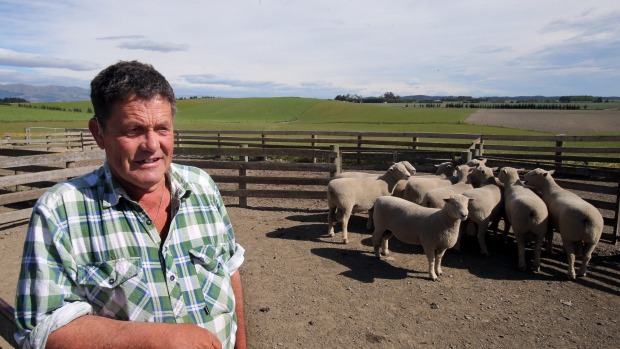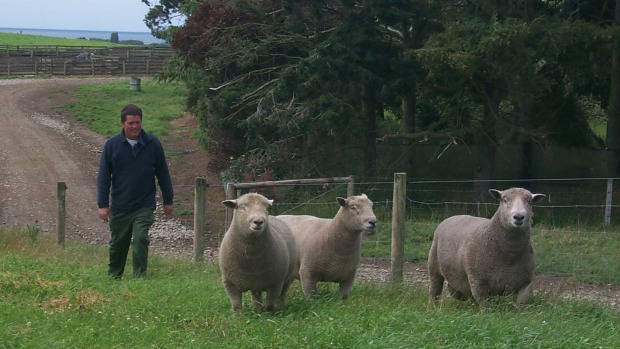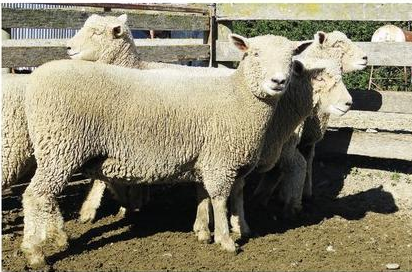By PAT DEAVOLL – NZ Farmer

Waimate southdown stud breeder believes stockmanship plus record keeping, pedigree and understanding what is behind the animal.
Topping ram sales provides undeniable satisfaction for Chris Medlicott, only bettered by producing fertile commercial southdowns, writes Pat Deavoll.
A top price of $16,000 for a southdown ram at the Christchurch Ram and Ewe Fair is just the icing on the cake for stud breeder Chris Medlicott. Record sale prices are satisfying, but remain secondary to the Waimate farmer’s main drive of producing top commercial sheep.

Southdown stud breeder Chris Medlicott had the top price at the recent Christchurch ram sale for his southdown ram Clifton Downs-279-14.
Even so there is no doubt Medlicott is good at what he does. Since 1997 he has consistently topped the sales, and in 2003, and again in 2005, broke the world record for the price paid for a sheep.
“A lot of the guys I sell rams to were getting 400 lambs off mum a few years ago, and now they are getting 900 lambs. I take more pleasure out of that than the record prices my rams make,” he says.
Clifton Downs-279-14 (which topped the Christchurch sale this year) was sought after by several southdown breeders with commercial operations, Medlicott says.
“They all said he was the ram they wanted, which I got a buzz out of. They were bidding up to $10,000, then the price got too high and they fell off. Todd and Fleur Anderson (of Winton) bought him.
“The bidders reckoned he was the ideal flock ram. His progeny would have enough condition at 14 kilograms to be marketable to the works, but have the conformation to take them through to 21 kilograms if necessary.”
A lot of high growth rate sheep are too lean and not prime enough to go to the works at 14kg, Medlicott says. The commercial farmer needs lots of options because climactic factors like drought or a cold winter can cause delays in fattening lambs.
Medlicott has recently merged his own southdown stud, Tasvic Downs, into the Clifton Downs stud, which he took over from his father Bill in 2003.
“Tasvic Downs doesn’t exist now but in saying that Clifton Downs-279-14 was out of a Tasvic ewe.”
Clifton Downs Stud was started by the partnership of Medlicott’s grandfather Jack, and his father Bill. They were entering the Smithfield lamb competitions, but couldn’t find the terminal sires to produce lambs to do well, says Medlicott. So they started their own southdown stud which grew to become one of the leading flocks in New Zealand.
Friends visiting from Australia in the 1970s had bought a ewe at a dispersal sale at the renowned Punchbowl Stud outside Oamaru. The ewe cost $400, a considerable sum of money in those days. It was given to Medlicott, aged 15 at the time, as a thankyou for his family’s hospitality.
For a stud to be registered, 10 ewes were needed so Medlicott was given another ewe by southdown breeder John Macaulay, and his father gave him the other eight.
“Instead of studying for school cert I was busy looking up pedigrees,” he says.
“I kept building up the numbers and in 1992 got a first prize at the Christchurch A&P Show, and the second highest price for a ram at the sale that year. The ram (Tasvic-27-90) sold for $3400 and was exported to America.”
Since then Medlicott has twice topped $16,000 for a ram and reached about $14,000 “a few times.”
Southdowns rank well ahead of other breeds at the sales, Medlicott says.
“Southdown breeders are not frightened to stand up and spend money on a top ram. The Andersons have bought a lot of expensive rams off me. And one of the families who gave me my first ewe is buying semen off this ram. It will be going to the AI station next week. So the purchaser has made an investment for his flock but is also able to sell semen all around the world.”
He says there has been interest in the ram from South America, and the animals “easy-doing” type will be ideal for the native grasses its progeny will be expected to feed on. The ram has good muscle and good growth but has a “soft handle,” Medlicott says. By this he means the animal has a soft muscle, with an even cover, and a little bit of subcutaneous fat.
“The world has become “anti-fat,” and New Zealand sheep too lean. There still needs to be a degree of fat for an animal to function, he says.
“I feel there has been too much emphasis on growth and leanness in the past. I’m interested in a sheep that will grow as well as put down muscle, so a farmer in drought conditions or a cold winter like Southland’s been through, still has the ability to fight off the elements and have a product at the end of the day. You can get this through genetics, but it’s also important to use stockmanship. There needs to be balance.”
Medlicott has been cat-scanning his rams, and strategically mating the best with a fattier-type ewe. There have been trials done in Australia where a sheep with moderate growth, good handling, conformation and “easy doing” has been getting as good as or better growth rates in extreme conditions as really lean sheep.
“The other thing that is interesting about Clifton Downs-279-14 is that although he wasn’t the highest scanner, he had a very good hindquarter and a reasonable eye muscle area (EMA). I’ve EMA’d all my rams and finding that the highest cat scans are not quite as high as the EMA scans. My theory is that there might be more intramuscular fat in some of the higher muscled animals. I think we need intramuscular fat – we’ve seen it in the beef world – for the animal to survive and taste good. As ram breeders, I think we need to study what’s going on in the beef world and makes some informed decisions.”
Southdowns were very popular in the 1950s and 1960s but by the 1970s had become over-fat and lost ground. Medlicott says his grandfather was selling 180 rams a season in the 1960s. A decade later it had got so bad, one year he only sold seven rams.
“Breeding southdowns in the 1970s and 1980s, you wondered why you did it. I got rubbished by mates, but I could still see a future in them.”
As a stud breeder, Medlicott feels he must always be thinking ahead to where the market is to be profitable. And change needs to be fronted by the leading farmers and breeders.
“I’m always trying to go the next step – think where the industry is going and try and anticipate it.”
These days southdowns are a popular terminal choice. For good early maturity and “out the gate in a hurry” efficiency they take a lot of beating, Medlicott says. They have created a niche for themselves in Southland, Canterbury and Hawkes Bay.
“It comes down to their consumption of dry matter to output efficiency.”
Medlicott doesn’t use estimated breeding valuations (EBVs); I’m “outside the square,” he says.
“I am very interested in EBVs and have been told by my peers I should be on Sheep Improvement Ltd (SIL), but I’m not. SIL is rewarding extreme growth and leanness and I think this is promoting the wrong animals.”
“For me it’s stockmanship plus record keeping and pedigree and understanding what is behind the animal.”
Medlicott thinks his ewes are the most important part of his flock. A lot of breeders get wrapped up in their rams, he says, but the maternal lines are essential. Ewes with “a whole lot of good breeding in the background” will keep on performing
His stud is only about 20 per cent of his income, but it is his passion.














